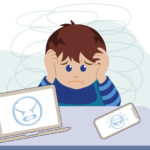Bullying at all ages: How to spot the signs and support your child

According to the National Center for Educational Statistics, nearly a quarter of students ages 12 to 18 reported being bullied at school in 2019. But bullying can happen almost anywhere — through exclusive group-texts, the creation of hurtful memes, “Finstagrams” (fake Instagram accounts sometimes used for harassment), and more classic offline methods parents themselves may have experienced growing up.
Many kids hide their experiences with bullying because of the stigma attached to it, so you might not notice the signs. But that doesn’t mean they’re not affecting your child.
For insights on behavior that may indicate your child is being bullied, we spoke with Desiree Gillpatrick, an integrated behavioral health clinician at Village Pediatrics, part of Boston Children’s Primary Care Alliance.
Signs of bullying in young kids
Among elementary school-age children, bullying generally takes the form of name-calling, excluding, or pushing, shoving, or tripping another child.
“Younger children use behavior as their primary way of communicating,” says Gillpatrick. “Therefore, signs and symptoms of bullying in younger children are most recognizable through behavioral changes.”
In elementary school-age children, the role of “bully” and “victim” can fluctuate. One day a child may be bullied and the next the child could be the bully. And bullies often look to pick on younger children.
Examples of signs that parents should be aware of include:
- regression to previous developmental milestones
- changes in eating or sleeping
- sudden fearfulness
- stomachaches
- headaches
- unexplained injuries
- school avoidance
- frequently losing clothes or toys
Signs of bullying in middle schoolers
The most common form of bullying among older children is spreading rumors and gossiping, which is often done in group chats or on social media. In fact, 15 percent of middle and high school students report being bullied online or by text.
The social and physical changes that happen during middle school can amplify bullying and make your child a target for an array of reasons. These can include body changes, physical appearance, friend groups, sports — or lack of playing sports — and more.
Being in constant contact via social media can also put a huge strain on mental health. With social media, some kids have a harder time recognizing bullying, and when they do, they are more prone to keep this a secret from adults than if it had occurred in school.
Middle school students are learning to manage interpersonal relationships and are beginning to learn how to verbalize their concerns. “However, talking to a parent at this age remains a challenge due to fears of retaliation or feeling vulnerable,” Gillpatrick explains.
Middle schoolers may display all of the same signs noted above for younger kids, as well as a few age-specific signs, including:
- declining school performance
- social isolation
- loss of interest in previously enjoyed activities
- difficulty sleeping
“In terms of advice to give your middle schoolers, remember that they are not constantly supervised by adults like younger kids,” explains Gillpatrick. “We advise our middle schoolers to travel with a peer or to find safety in groups.”
Signs of bullying in high schoolers
It can be more challenging to spot bullying in high schoolers. These teens are often less inclined to confide in a parent if they are experiencing bullying.
“Even though teens have the language to communicate, they still express themselves mostly through their actions,” explains Gillpatrick. Notice if your teen demonstrates changes in behaviors such as spending more or less time on their phone, lashing out, or experiencing disciplinary problems at school.
Other signs of bullying at this age can include:
- risky behaviors
- physical altercations
- self-harm or expressing thoughts about self-harm
“Many of these signs overlap with other mental health difficulties, so symptoms in combination with any verbal statement should be taken seriously,” explains Gillpatrick. “It’s crucial to respond with support so you can have an open dialogue and your teen feels comfortable coming to you with hard conversations.”
Helping a bullied child
Learning that your child is being bullied — at any age — can trigger lots of emotions. And it’s important to take your child seriously. This is also important if they are being targeted because of their race, ethnicity, gender, gender expression, sexual orientation, or disability.
“Helping your child to open up is the first step; then parents can help address the cause of bullying more effectively,” Gillpatrick says. “Staying calm is key.”
When you talk to your child, remind them that you love and support them unconditionally. Ask open-ended questions about what happened and when.
If they seem open to your help, encourage them to not respond to the bullying. Document the problem, including screenshots if it is cyberbullying, and other forms of evidence. If necessary, notify your child’s school or the police.
For each age group and individual situation, parents can also brainstorm how to address the problem with their child. Discuss how the bullying makes them feel and behave outside of school, too. Sometimes, a child’s response overlaps with other mental and behavioral health issues. In these scenarios, your pediatrician is a valuable resource for guidance.
Reaching out to your pediatrician can be the first step to finding the help you and your child need. Many Boston Children’s Primary Care Alliance practices offer support for mental and behavioral health. Find a practice near you.
Related Posts :
-

Parents can help end bullying by always being open to conversation
You just saw your teen get pushed at the bus stop. Or maybe you suspect that bullying is behind your ...
-

The great mask debate: how to deal with bullying over face masks in school
As the war against COVID-19 rages on, so do the battles about the best ways to stop the spread. And, ...
-

When your child is the bully: Tips for parents
It’s bad for children’s health, makes headlines, and defies most attempts to prevent it. Bullying has become the “...
-

Cyberbullying in the age of COVID-19: How to protect your kids
Now that so many classrooms across the country have moved totally or partially online, kids of all ages are spending ...





